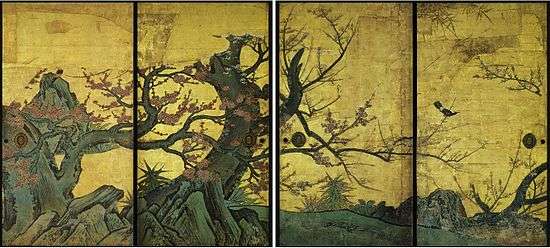Kanō Sanraku


Kanō Sanraku (狩野 山楽, 1559 – September 30, 1635) was a Japanese painter also known as Kimura Heizō (his birth name), Shūri, Mitsuyori, and Sanraku.[2][3][4] Sanraku's works combine the forceful quality of Momoyama work with the tranquil depiction of nature, and they have a more refined use of color typical of the Edo period.[5]
Life
His father was the painter Kimura Nagamitsu[2] who flourished circa 1570, and he was born in Shiga Prefecture and died in Kyoto.[4]
Sanraku worked for Toyotomi Hideyoshi[2] in the 1570s,[4] which led to him studying under and being adopted by Kanō Eitoku.[2][4] Sanraku was the half-sibling and teacher of Kanō Sansetsu,[4] and became Eitoku's son-in-law and later the head of the Kanō school.[2] When Sanraku had no son he married Kanō Sansetsu (1589–1651) to his daughter and adopted him. Sansetsu and his school remained in Kyoto when most Kanō artists moved to Edo (often after a summons from the shogun), and he continued to adhere to the brightly coloured style of the Momoyama period. His son Einō painted in the same style, but is better known for a biographical history of Japanese painting, which gave the Kanō school pride of place.[6]
Sanraku's patrons included Tokugawa Hidetada.[2] Like most Kanō artists of the period, he painted in a variety of styles, including both large works for decorating castles (like the two illustrated), and smaller scrolls, often in a monochrome style derived from Chinese ink-wash painting.
Works
- The three laughing men of the valley of the tiger, screen, color, India ink, and gold on paper. Tokyo National Museum.[2]
Notes
- ↑ Analysed at Watson, 44; following Chinese convention, the smaller female tiger has spots.
- 1 2 3 4 5 6 7 Hetl-Kuntze, H. (1969). Hans L. C. Jaffé, ed. Far Eastern Art. The Dolphin history of painting. Translated by German Erich Wolf. Thames and Hudson. p. 117.
- ↑ "Kanō Sanraku (Japanese painter, 1559-1635)". Union list of artist names online. J. Paul Getty Trust. 2004. Retrieved 2007-11-14.
- 1 2 3 4 5 "Kano Sanraku". The concise Grove dictionary of art. Oxford University Press. 2002. Retrieved 2007-11-14.
- ↑ Paine, 197–198; Watson, 44, 51–53
- ↑ Paine, 208
References
- Paine, Robert Treat, in: Paine, R. T. & Soper A, The Art and Architecture of Japan, Pelican History of Art, 3rd ed 1981, Penguin (now Yale History of Art), ISBN 0140561080
- Watson, William, The Great Japan Exhibition: Art of the Edo Period 1600–1868, 1981, Royal Academy of Arts/Wiedenfield and Nicolson
External links
- Momoyama, Japanese Art in the Age of Grandeur, an exhibition catalog from The Metropolitan Museum of Art (fully available online as PDF), which contains material on Kanō Sanraku
| Wikimedia Commons has media related to Kanō Sanraku. |
